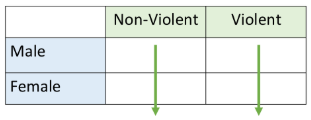Chapter 14 - Factorial ANOVA
1/13
There's no tags or description
Looks like no tags are added yet.
Name | Mastery | Learn | Test | Matching | Spaced |
|---|
No study sessions yet.
14 Terms
Factorial ANOVA
when you have more than 1 factor (IV)
factors can be…
all between-subjects
all within-subjects
a mix of between- and within-subjects
Naming Factorial ANOVAs
2(gender) x 2(condition) factorial ANOVA
indicates two levels of gender and two levels of condition.
3 Questions in Two-Factor ANOVA
how does gender (male vs. female) affect aggression
main effect of Gender
how does condition (violent vs. non-violent game) affect aggression
main effect of Condition
does the effect of condition on aggression depend on one’s gender? Or does the effect of gender depend on one’s condition? Or is aggression affected by specific combinations of condition and gender?
interaction between gender and condition
ANOVA Matrix
a table that organizes the results of an ANOVA test and displays the effects of each factor and their interactions
use “appear” or “seem” when reporting results because it looks like there is a main effect but we have to test to be sure

ANOVA Matrix — Main effect of gender
average aggression from males across both conditions
average aggression from females across both conditions

ANOVA Matrix — Main effect of Condition
average aggression in violent condition across both genders
average aggression in non-violent condition across both genders
ANOVA Matrix — Interaction
are the males and females both affected by the condition in the same way?
look at difference between conditions across both rows
Male Non-violent = 7, Male violent = 9 — +2 difference
Female Non-violent = 3, Female violent = 5 — +2 difference
so seems like there’s no interaction
Interactions
the effect of one variable depends on another variable
the effect of one variable differs based on another variable
there is additional variability beyond the 2 main effects — your conclusion from your main effects changes across levels of another variable
ex; drug interactions (this medication will help you, unless, you are also taking drug X)
The power of Factorial ANOVA
allows us to answer a more complex research questions
can take into consideration the interaction of factors
helps to guide human behaviour and interventions from research
perhaps a therapy is only effective for younger and not older children
perhaps social media use is more harmful for girls than boys
harmful for everybody but more for girls
Statistical Hypotheses — Main effect of factor A
H0 = μA1 = μA2
H1 = μA1 ≠ μA2
Statistical Hypotheses — Main effect of factor B
H0 = μB1 = μB2
H1 = μB1 ≠ μB2
Statistical Hypotheses — Interaction
H0: there is no interaction between factors A and B
H1: there is an interaction between factors A and B
Results Statement
results indicated that there were no significant main effects of food type, F(1,16) = 3.75, p > .05, or room temperature, F(1, 16) = 3.75, p > .05. However, there was a significant interaction between food type and room temperature, F(1,16) = 10.42, p < .05.
Simple Main Effects
when you find a significant interaction, you need to run follow-up teests to test which levels of your interaction are significant
significant interaction does not tell you which specific levels of the variables are significantly different…you need to run simple main effects to find out